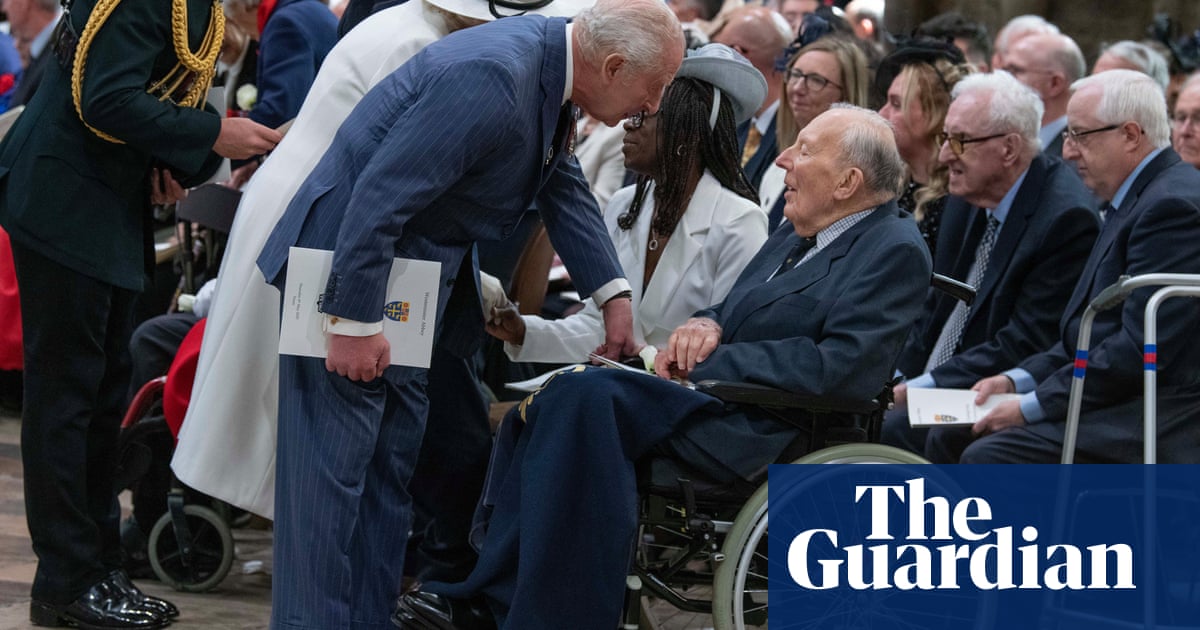Eighty years ago, Westminster Abbey opened its doors all day and late into the night for short services. About 25,000 attended to give thanks and to remember those who had made the ultimate sacrifice, asVE Daymarked the end of almost six years of war in Europe.
On Thursday’s anniversary it was again the focal point of UK national commemorations, with a service of thanksgiving weaving poignant reminders of war’s deprivation and loss with the hopes for the future that historic day had promised.
A group of 78 veterans, many wearing the medals attesting to their second world war service, attended as King Charles led the nation in a two-minute silence.
In workplaces, railway stations and shops people stood, heads bowed on the stroke of noon in remembrance. Services and ceremonies were held across the UK and Europe.
Inside the abbey, it was the veterans who were honoured, by a congregation of royalty, politicians and military. Some in wheelchairs, others leaning heavily on sticks, they were presented with white roses, signifying peace, handed to them by six young people. It was a reminder that as time continues to claim first-hand witnesses to the war, the younger generation will shoulder responsibility for remembrance.
Echoes of the dark days of war were woven tightly into the order of service.
A “procession of witness” saw wartime artefacts from the armed forces and home front carried through the abbey on velvet cushions and carefully placed on the high altar: a D-day map, a set of campaign medals, a naval ratings cap, an RAF flying helmet, an air raid warden’s helmet, a child’s gas mask and a volume of the Book of Civilian War, recording the names of all non-combatants killed across the UK.
Readings from wartime letters brought history alive.
One was from frontline soldier Fredrick Burgess to his seven-year-old son, Freddie. It was written just seven months before the lance corporal was killed in action.
Another, from Janet Thornton to her teenage daughters on VE Day, urged them to remember the sacrifice and the importance of the day but also to “shout, scream, sing, wave flags, eat, drink – lemon or barley water – and make it a day of rejoicing”. Her grandson Colin Vallance-Owens was in the abbey to hear her words. “She felt very, very seriously that this was a very, very important day for all of us,” he told the BBC.
An excerpt from Winston Churchill’s 8 May radio broadcast from the Cabinet Office ricocheted off the abbey’s stone walls. His great-great-grandson Alexander Churchill, 10, was given the honour of lighting the VE Day candle and read a prayer for “peace in Europe and across the world”.
It was left to the archbishop of York, Stephen Cottrell, in his address, to remind the congregation that those hopes of VE Day, and all the good that had come as the result of peace, would be sorely tested.
“Those first outpourings of joy on the first VE Day led to something good, because in our opposition of what was worst in us, we discovered what was best,” he said. “All this good is under threat again in our world today.”
The king, on behalf of the nation and Commonwealth, placed a wreath on the tomb of the Unknown Warrior, with the message: “We will never forget.” The Prince of Wales followed with a wreath on behalf of veterans and the second world war generation. The tributes comprised seasonal flowers that would have been in bloom 80 years ago, including pink, white and peach roses.
After the service, members of the royal family chatted with the veterans.
Outside the abbey, Queen Camilla and the Princess of Wales placed posies, picked from Windsor Castle’s grounds and estate, on the memorial to innocent victims: rosemary for remembrance, oak for endurance and longevity, and bluebells for gratitude.
Four days of national commemorations will conclude with a televised VE Day 80 concert from Horse Guards Parade on Thursday evening.
